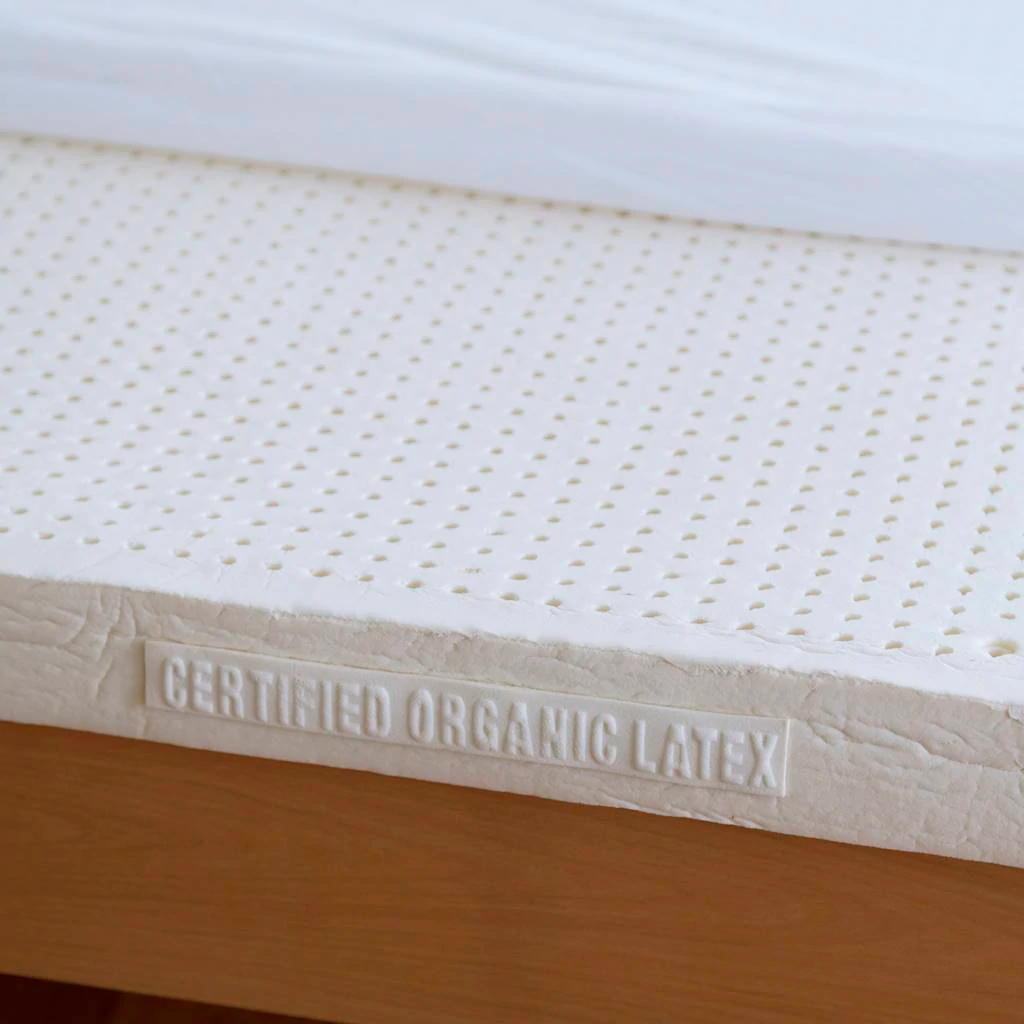A latex mattress lasts about 12-20 years, which is longer than any other mattress type. The lifespan depends on the latex type and manufacturing process – whether it’s all-natural, synthetic, or blended, and if it’s made using the Dunlop process or Talalay process.
Whether you have owned a latex mattress for some time or are looking to upgrade, it’s wise to question how long does a latex mattress last?
Latex is known for its natural composition. This quality makes it more durable than any other type of mattress, but knowing this is not enough. Other factors greatly affect the lifespan of latex mattresses, including the latex used, whether it’s all-natural, and your maintenance routine.
If you’re doing deep research trying to find the best latex mattress for you or if you need to replace yours, then this guide covers:
- Factors affecting how long the mattress lasts
- How to prolong lifespan
- And loads of our communities frequently asked questions!

Latex Mattress Construction: How It Affects Lifespan?
Whilst one of the advantages of latex is that they last 20 years, factors such as the type of latex influences how long they last: There are two types of latex foam:
- Dunlop latex
- Talalay latex
Both Dunlop and Talalay latex are made of the liquid sap from rubber trees. The main difference between the two is their manufacturing process where talalay takes longer and results in a softer foam with increased breathability and pressure relief.
Natural Vs. Synthetic Latex
Not all latex mattresses on the market is made up of all-natural latex. There are synthetic ones made from styrene-butadiene rubber that tries replicates the structure of natural latex and provides an alternative to the 4.3% of the general population who are allergic to latex.
Unlike a natural latex mattress, synthetic latex breaks down faster because of its components which are man-made and toxic materials. Because of this, it only lasts around 6-10 years.
Although a mattress manufacturer won’t usually market their product as synthetic, you can look out for Global Organic Latex Standard (GOLS) certification.

Global Organic Latex Standard (GOLS) certifies organically grown natural rubber latex products. This ensures that these products contain certified natural rubber latex and other approved additional materials that comply with their regulations.
When you buy a mattress with GOLS certification, you can be assured that your mattress is dust mite resistant and made from sustainable materials.
An example of a GOLS certified mattress is Avocado Green Mattress which is 100% organic, non-toxic, and biodegradable.
Blended latex mattresses
These latex mattresses blend natural and synthetic latex. This often comes as a 60/40 or 70/30 synthetic to natural latex ratio.
Blended latex is suitable for buyers with a tighter budget as they’re cheaper than their all-natural counterparts. But to reiterate, more natural materials means increase durability and will last longer.
Tips To Prolong Lifespan Of A Latex Mattress
Aside from regular cleaning and maintenance, here are some more tips for prolonging the lifespan of your mattress. After all, a latex mattress will last around 20 years so these tips can really help!
1. Use A Mattress Topper
Using a mattress topper can help increase the longevity of a latex mattress in several ways:
- Protection: A mattress topper can act as a barrier between the mattress and spills, stains, and other sources of wear and tear.
- Comfort: A mattress topper can provide an additional layer of cushioning, which can help alleviate pressure points and improve overall comfort.
- Support: A mattress topper can help redistribute weight and provide added support, which can help prevent sagging and maintain the shape of the mattress.
A latex mattress topper is a good option as it can provide an added layer of support and cushioning, while also being durable and long-lasting. It is also hypoallergenic, naturally cooling, and can be a good option for people with allergies or asthma.
The thickness of the topper can vary depending on personal preference, but a topper 2-3 inches thick is considered a standard and good thickness to provide extra comfort and support without changing the feel of the mattress too much.
2. Use A Mattress Protector
If you don’t fancy using a topper, then a mattress protector is like a second bedsheet fitted to your mattress. They are made from cotton, polyester, or other materials designed to repel liquid, dirt, dust, and other allergens and can be waterproof. If you have a stain-prone lifestyle, for example,
- You sleep with a child.
- You sleep with a pet.
- You love eating or drinking in bed.
Installing a mattress protector will help you prevent stains. That means sweat, body oils and other accidents and spills won’t make it through to the latex and damage it. Protecting your mattress will ensure it retains its original quality for much longer and we recommend the following:
- Waterproof Bamboo Mattress Protector
- Dormeo Evercomfy Aloe Vera Mattress Protector
- The Nectar Mattress Protector
Use A Proper Mattress Foundation
A mattress foundation for an innerspring mattress will not be suitable for a latex beds. To maximise the best properties of a latex mattress invest in a proper mattress foundation. It’s recommended to buy one which is:
- Sturdy and non-flexing support
- Foundation with slats made of ¾ inch thick wood and spaced no more than three inches apart
A latex mattress is not self-supporting, which you can observe when it is lifted on both sides, and it droops in the middle. This is why sturdy and non-flexing support is needed. Else, you’ll end up with a sagging bed.
Bed slats for latex mattresses encourage a breathable foundation to lessen the risk of moisture accumulation. Although a latex mattress is naturally mould resistant, a moist environment will promote mould growth.
What Causes a Latex Mattress to Age Faster?
Here are our 5 main reasons that cause latex to age faster:
- Exposure to heat and moisture: Latex can become weakened and degraded when exposed to high temperatures and humidity.
- Lack of proper support: A latex mattress needs a solid base to maintain its shape, if it’s placed on an unstable surface, over time it can sag and lose its shape.
- Lack of maintenance: Regular maintenance like rotating, flipping, vacuuming and airing out is necessary to keep your latex mattress in good condition.
- Improper cleaning: Using harsh chemicals or cleaning solutions can damage the surface of the mattress and shorten its lifespan.
- Overweight and heavy usage: Overweight and heavy usage can put more pressure on the mattress and cause it to wear out faster.
Do You Flip A Latex Mattress?
There is no need to flip a latex mattress. Latex quickly bounces back to its original shape when pressure is removed, reducing the need to flip.
Innerspring mattresses, traditional memory foam and hybrid mattresses may need regular flipping or rotating the mattress to help keep the comfort fillings evenly distributed.
Do Latex Mattresses Get Softer Over Time?
Latex mattresses get softer over time. When a latex mattress is new, it can be extra firm at first and would need breaking in for up to two weeks.
But beyond the breaking-in period, a latex will not get softer like a gel memory foam mattress, traditional memory or polyurethane foam. According to a latex mattress company called Spindle:
- latex foam is estimated to soften 15-20%
- memory foam about 30%
- polyurethane about 60% over ten years.
Do Latex Mattresses Sag?
Latex mattresses won’t sag significantly over the years, unlike soft foams like memory foam and polyurethane foam. Latex foam is only estimated to soften 15-20% over ten years.
A latex mattress is naturally durable and springy, which means it can recover quickly after applying pressure. It is resistant to compression. Hence the risk of sagging over time is low.
Does Latex Foam Break Down Over Time?
Latex foam will break down over time as with any natural and man-made material. Heat can speed up the breakdown of latex foam. That’s why is it crucial not to expose latex foam mattresses to direct sunlight and high-heat devices.
How Often Should I Replace My Latex Mattress?
A latex mattress can last up to 20 years. But how often you should buy a new mattress depends on your care routine, usage and how comfortable you feel. When a mattress is already in its final years, it can sag, have uncomfortable lumps, and wear and tear beyond fixing.
Here are 5 questions to know if your mattress is worn out:
- Is your latex mattress sagging?
- Does your latex mattress have dirt or moulds beyond cleaning?
- Does your latex mattress give you body aches?
- Do you sleep better on other beds?
- Is your latex mattress more than 20 years old?
Is It Worth Buying A Latex Mattress?
With its prices ranging from £500 to £2000, any buyer would take a second thought to buying a latex mattress. But knowing it can last 12-20 years and possibly more if you properly care for it, we can say that it is worth buying a latex mattress.
1 Sources
- Wu, M., McIntosh, J., & Liu, a. J. (2016, March). Current prevalence rate of latex allergy: Why it remains a problem?. Retrieved from National Center for Biotechnology Information:
https://www.ncbi.nlm.nih.gov/pmc/articles/PMC5356959/





